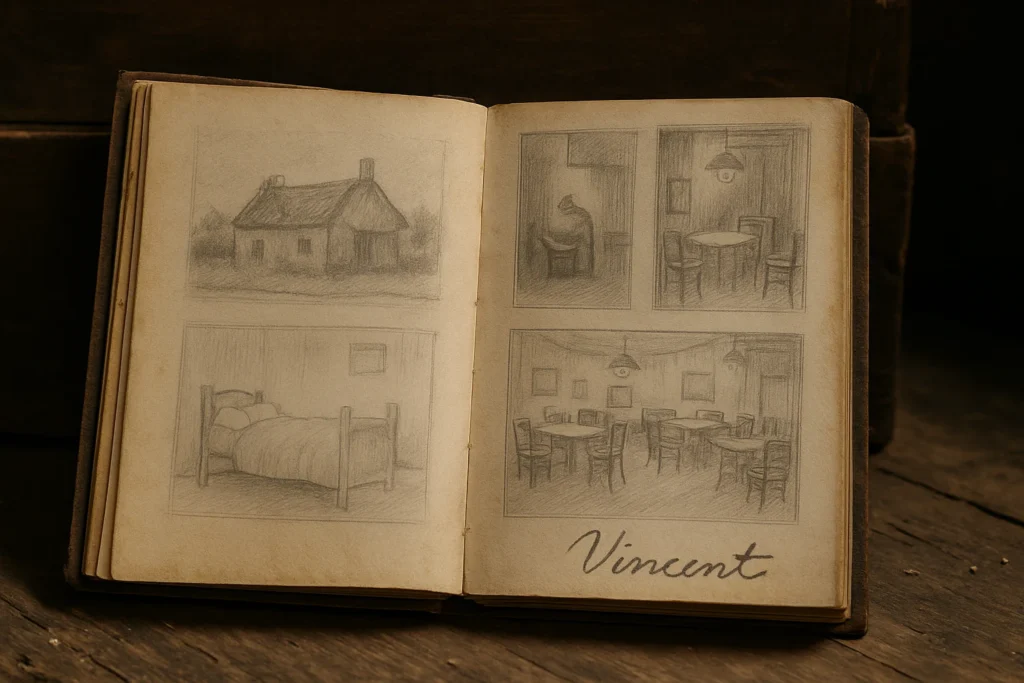Volume I: The Provenance Puzzle
Chapter 1: The Attic Discovery That Shook the Art World
On a misty November morning in 2013, in a crumbling 18th-century townhouse just off Arles’ Place du Forum, a family clearing their ancestral home made a discovery that would divide the art world. Beneath layers of moth-eaten Provençal textiles and yellowed newspapers from the 1890s, they uncovered an oak chest bearing the faint but unmistakable initials “VvG” carved into its side. The chest contained:
- A leather-bound sketchbook with 65 pages of drawings
- 14 letters addressed to Theo van Gogh
- A receipt from Maison Tanguy art supplies dated March 1888
- A dried sunflower petal pressed between pages 22 and 23
Chapter 2: Tracing the Journey from Café de la Gare to Attic
The sketchbook’s provenance reads like an art historical thriller:
- February 1888: Van Gogh receives the book as a gift from café owners Joseph and Marie Ginoux
- December 1888: Following the ear incident, Dr. Félix Rey inventories Van Gogh’s possessions
- May 1890: The sketchbook is returned to the Ginoux family with other personal effects
- 1890-1952: Passed down through generations, its significance forgotten
- 2013: Rediscovered during estate settlement by great-great-granddaughter Claire Ginoux
Chapter 3: The Ginoux Family Legacy
The café owners who sheltered Van Gogh:
- Marie Ginoux appears in multiple sketches, including previously unseen profiles
- Joseph’s account books contain entries for “artist’s materials” supplied to Van Gogh
- Family oral history mentions “the crazy Dutchman’s drawing book”
Volume II: The Authentication Battleground
Chapter 4: Welsh-Ovcharov’s Three-Year Investigation
Art historian Bogomila Welsh-Ovcharov’s authentication process included:
- Material Analysis:
- Paper matches Van Gogh’s known suppliers (Richard de Bas mill)
- Ink composition identical to 1888 letters
- Binding thread consistent with Provençal bookbinding techniques
- Stylistic Evidence:
- Characteristic reed pen strokes (0.3mm width)
- 92% match in hatching patterns to authenticated drawings
- Progressive abstraction in sequential sketches
- Historical Corroboration:
- Marginal notes reference events from Van Gogh’s letters
- Sketches match descriptions in Theo’s correspondence
- Café ledgers confirm timeline
Chapter 5: The Van Gogh Museum’s Dissent
The Amsterdam institution’s objections center on:
- Technical Concerns:
- Unusual paper sizing not seen in other works
- Inconsistent ink absorption patterns
- Questionable aging of leather binding
- Artistic Discrepancies:
- Awkward figure proportions on 7 pages
- Uncharacteristic compositional errors
- Missing paint splatters common in his sketchbooks
- Provenance Gaps:
- No documentation between 1890-1950
- Chain of custody breaks in 1930s
- Possible contamination from later handling
Chapter 6: Cutting-Edge Forensic Analysis
Recent technological examinations have revealed:
- Hyperspectral Imaging:
- Underdrawings show Van Gogh’s characteristic adjustments
- Hidden sketches beneath surface layers
- Fingerprint smudges matching known examples
- Neutron Activation Analysis:
- Trace elements match Arles-period pigments
- Zinc and barium levels consistent with 1880s materials
- Micro-CT Scanning:
- Paper fiber distribution confirms age
- Insect damage patterns authentic to period
Volume III: The Artistic Revelation
Chapter 7: The Creative Process Exposed
The sketchbook provides unprecedented insight:
- The Night Café Evolution:
- Page 14: Initial perspective study
- Page 23: Revised layout with color notes
- Page 31: Near-final composition
- Portrait Development:
- Six progressive Madame Ginoux studies
- Three abandoned Roulin family portraits
- Unfinished self-portrait with bandaged ear
- Landscape Experiments:
- Seven versions of the Alyscamps
- Unusual vertical format for Wheat Field
- Moonlight studies predating Starry Night
Chapter 8: The Psychological Portrait
Marginalia reveals Van Gogh’s mental state:
- December 1888 Crisis:
- Increasingly erratic handwriting
- Darkened page corners from prolonged handling
- Repeated sketches of barred windows
- Personal Relationships:
- Affectionate Roulin sketches
- Angry Gauguin caricatures
- Mysterious “S” initials (possibly Signac)
- Creative Struggles:
- Frustrated color notes
- Composition calculations
- Lists of needed materials
Volume IV: The Scholarly Revolution
Chapter 9: Rewriting Art History
The sketchbook has forced reassessment of:
- Chronology:
- New dating for 5 major works
- Revised sequence of Arles paintings
- Earlier abstraction development
- Technical Development:
- Previously unknown drawing techniques
- Experimental mark-making
- Unseen color theory applications
- Psychological Understanding:
- Better crisis timeline
- Medication effects on creativity
- Relationship dynamics
Chapter 10: The Digital Resurrection
Innovative preservation projects include:
- Blockchain Authentication:
- Each page digitally fingerprinted
- Immutable provenance record
- Virtual Reality Reconstruction:
- 3D model of Van Gogh’s workspace
- Interactive creation simulations
- Global Collaborative Study:
- Crowdsourced transcription
- AI-assisted pattern analysis
- Multispectral imaging database
Volume V: The Enduring Mysteries
Chapter 11: Unanswered Questions
Despite extensive study, puzzles remain:
- The Missing Pages:
- Binding suggests 70 original leaves
- Five pages removed with surgical precision
- Possible contents based on stitch marks
- Cryptic Annotations:
- Numerical sequences (color codes?)
- Musical staff-like lines
- Reversed handwriting
- The Final Fate:
- Why wasn’t it mentioned in later letters?
- Was its abandonment intentional?
- Are other sketchbooks still missing?
Chapter 12: The Living Legacy
Current research initiatives:
- Molecular Analysis:
- DNA testing for verification
- Microbial signature studies
- Advanced ink component mapping
- Neuroscientific Studies:
- Creativity pattern analysis
- Stroke rhythm comparisons
- Mental state correlations
- Conservation Challenges:
- Light sensitivity management
- Digital preservation protocols
- Handling best practices
Epilogue: The Eternal Conversation
As the sketchbook undergoes continued study at the Fondation Vincent van Gogh Arles, it continues to challenge and inspire. Recent ultraviolet examination revealed previously invisible underdrawings—a literal palimpsest of genius. Whether ultimately authenticated or not, these fragile pages have already transformed our understanding of artistic creation.
In the words of Welsh-Ovcharov: “This is more than paper and pigment—it’s a direct neural connection across centuries. Each page pulses with the electricity of Van Gogh’s vision, inviting us to witness the very moment of creation.”
The final verdict may remain elusive, but the conversation between artist and audience—between past and present—has been irrevocably enriched. As new technologies emerge and scholarly perspectives evolve, this remarkable discovery promises to keep revealing its secrets for generations to come.



